外研版英语选修八 Module 2 The Renaissance Grammar 课件(共54张PPT)
文档属性
| 名称 | 外研版英语选修八 Module 2 The Renaissance Grammar 课件(共54张PPT) | 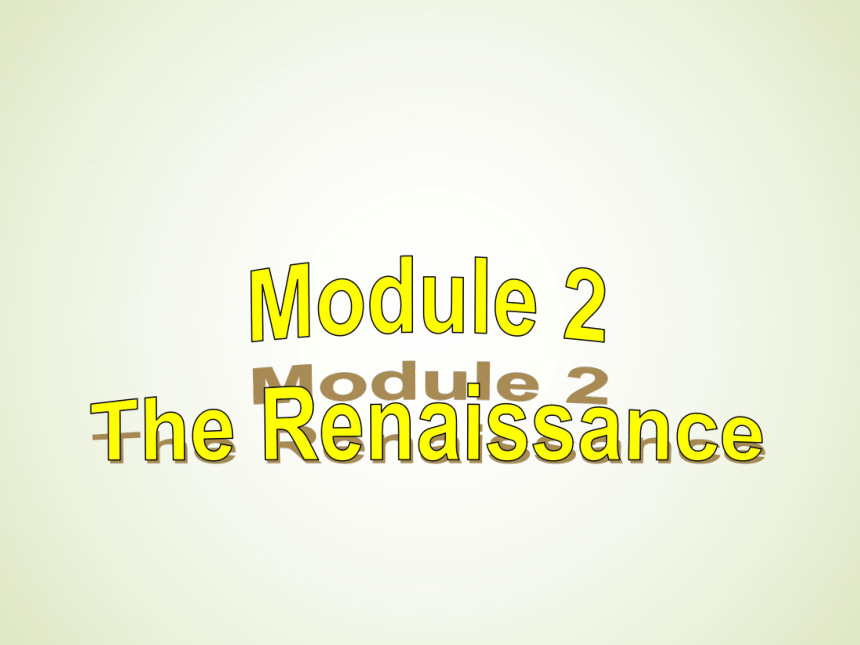 | |
| 格式 | zip | ||
| 文件大小 | 991.4KB | ||
| 资源类型 | 教案 | ||
| 版本资源 | 外研版 | ||
| 科目 | 英语 | ||
| 更新时间 | 2019-05-08 14:40:38 | ||
图片预览



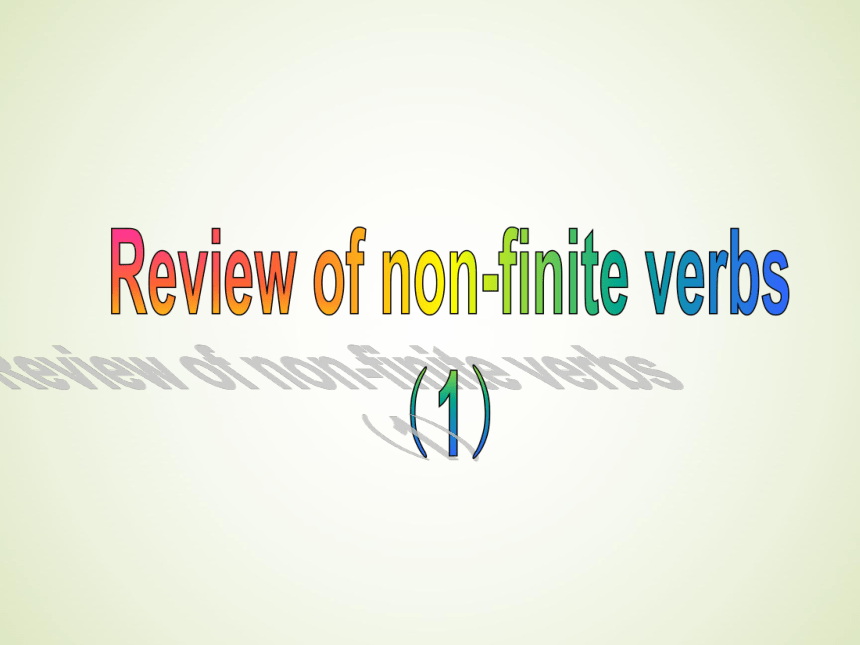
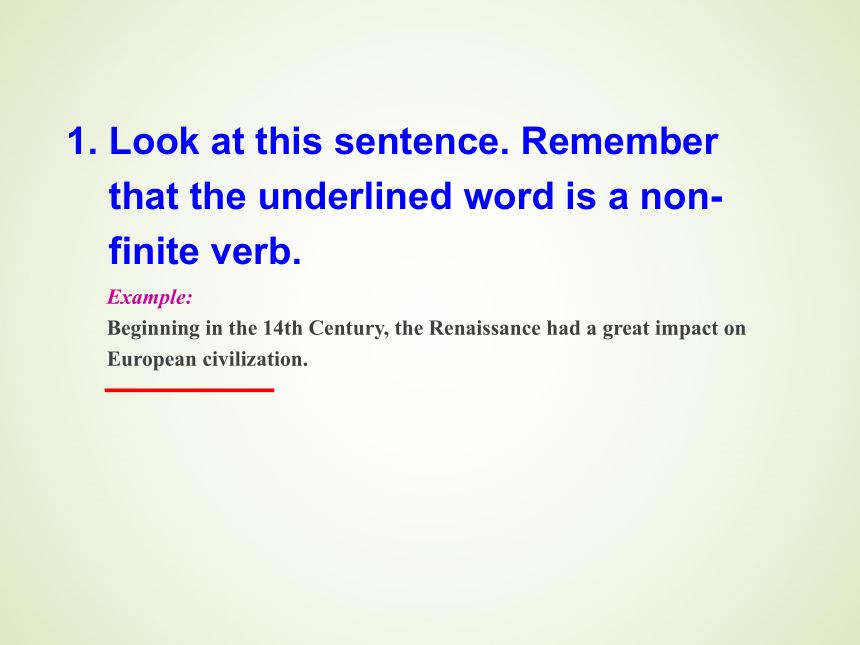

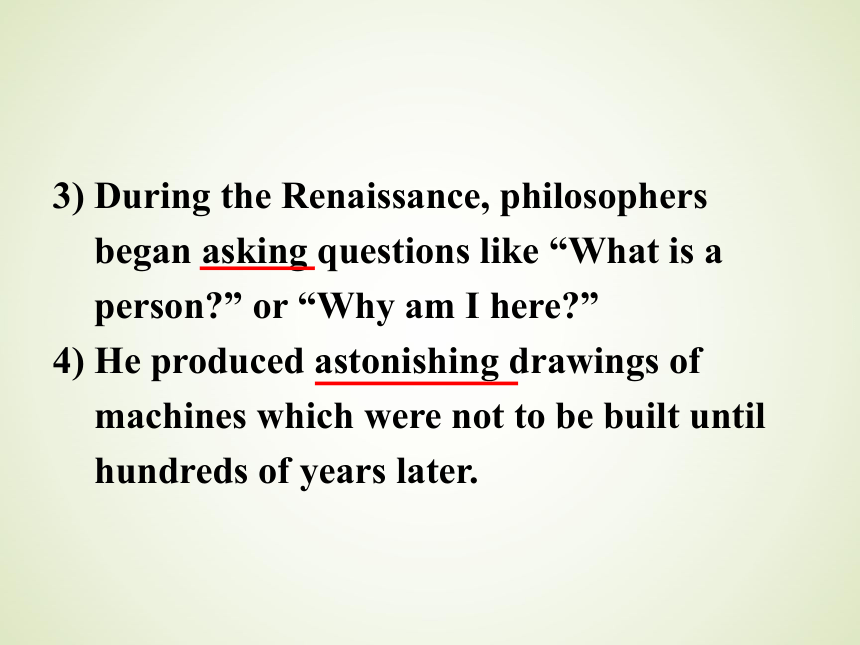

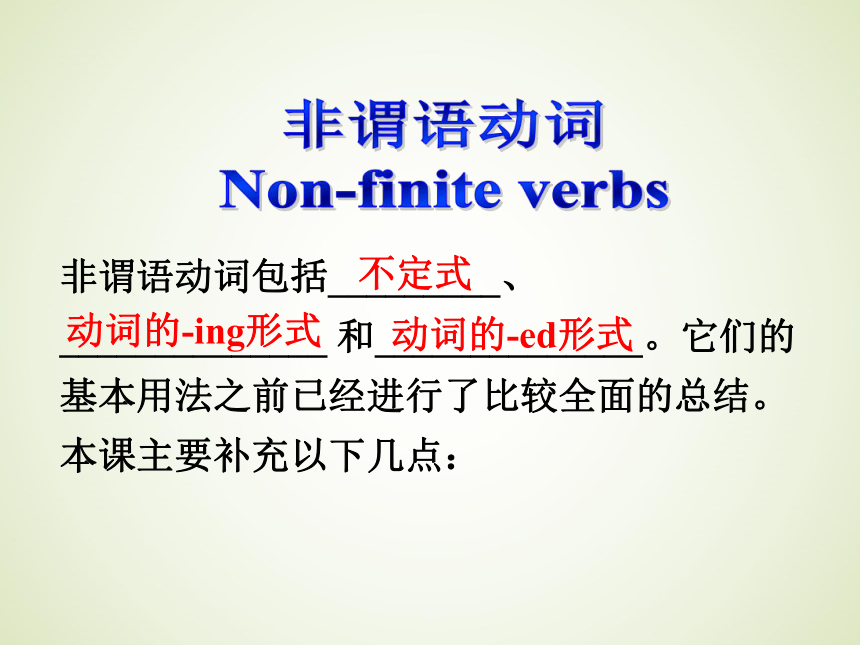
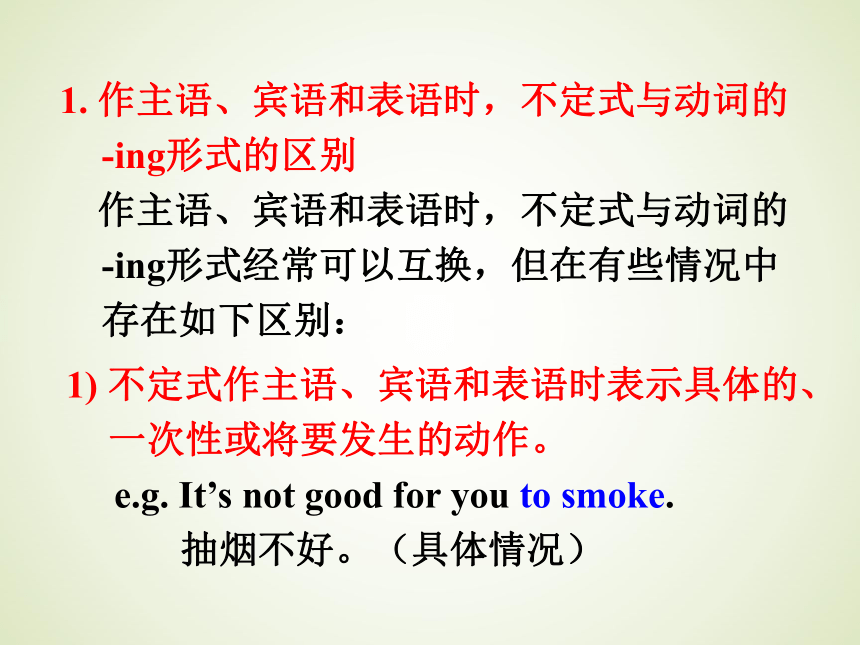

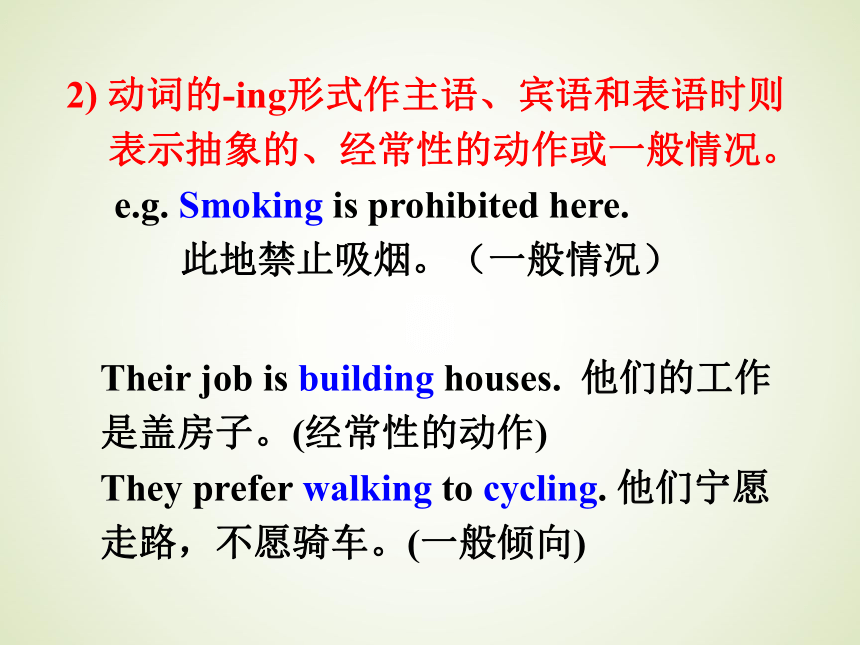
文档简介
课件54张PPT。Module 2
The RenaissanceTo review and practise the usage of non-finite verbsReview of non-finite verbs
(1)Example:
Beginning in the 14th Century, the Renaissance had a great impact on European civilization.1. Look at this sentence. Remember
that the underlined word is a non-
finite verb.1) Painted by Leonardo da Vinci in the years 1503~1506, the Mona Lisa is a mysterious masterpiece.
2) Architects preferred designing buildings with more light which contrasted with the heaviness of the Gothic cathedrals of the Middle Ages.Now underline the non-finite verbs in these sentences.3) During the Renaissance, philosophers began asking questions like “What is a person?” or “Why am I here?”
4) He produced astonishing drawings of machines which were not to be built until hundreds of years later.Which non-finite verb phrases:
(a) contain –ing forms?
(b) contain –ed forms?
(c) are used as subjects?
(d) are used as objects?
(e) are used as adjectives?2, 3, 41no2. Read the sentences in Activity 1
again and answer the questions.2, 34非谓语动词包括_________、______________ 和______________。它们的基本用法之前已经进行了比较全面的总结。本课主要补充以下几点: 动词的-ing形式非谓语动词
Non-finite verbs不定式动词的-ed形式1. 作主语、宾语和表语时,不定式与动词的-ing形式的区别
作主语、宾语和表语时,不定式与动词的-ing形式经常可以互换,但在有些情况中存在如下区别:1) 不定式作主语、宾语和表语时表示具体的、一次性或将要发生的动作。
e.g. It’s not good for you to smoke.
抽烟不好。(具体情况)Our task now is to increase food production.
我们现在的任务是提高粮食产量。(将要发生的动作)
He prefers to stay at home today.
今天他宁愿呆在家里。(一次性的动作)2) 动词的-ing形式作主语、宾语和表语时则表示抽象的、经常性的动作或一般情况。
e.g. Smoking is prohibited here.
此地禁止吸烟。(一般情况)Their job is building houses. 他们的工作是盖房子。(经常性的动作)
They prefer walking to cycling. 他们宁愿走路,不愿骑车。(一般倾向)2. 不定式作定语
1) 作定语的不定式与它所修饰的名词或代词在逻辑上可能是主谓关系,也可能是动宾关系。
e.g. The next train to arrive was from
New York.
It was a game to remember.2) 名词前有only, last, next, 序数词或形容词最高级时, 其后常用不定式作定语。
e.g. Rita was the only person to complain.
He was the first man to fly across
the Atlantic.3) 有些名词的同根动词后常跟不定式,因而它也常跟不定式作定语。
e.g. Their offer to assist in the work was
not taken seriously.
(比较:They offered to assist in
the work.) 3. 动词-ing形式作定语可表示正在进行的
动作,也可表示经常发生的或短暂的
动作以及经常存在的状态。
e.g. The woman sending her children to school is my history teacher.
A little child learning to walk often falls.
He mistook me for a friend, causing me some embarrassment.4. 过去分词作定语常表示被动或已经发生的动作。
e.g. We've met the doctors sent to
work here by the city hospital.5. 不定式作状语, 常表示目的、结果等。作结果状语时, 常用“only +不定式”结构, 表示未曾预料到的或令人不快的结果。
e.g. Alan lifted a rock only to drop it
on his own feet.6. 动词-ing形式或过去分词作状语时,可以表示时间、原因、结果、条件、让步、方式、伴随情况等。其前可用连词while, when, once, if, unless等。
e.g. Being a student, he was naturally
interested in museums.
Seen through the eyes of a young
friend, Einstein was a simple,
modest and ordinary man. She got to know them while attending a conference in Beijing.
These sentences, if analysed differently, will make no sense.7. 动词-ing形式表示正在进行的活动或反复的动作,而不定式则表示整个活动或事件的全过程。
e.g. I heard him talking to his mother
when I passed.
I saw him go out and disappear into the
rain.8. 感官动词和使役动词后要接省略to的不定式作宾语补足语,但用于被动语态时,需把to补出来。
e.g. Someone saw Mary enter the building
about the time the crime was
committed.
Mary was seen to enter the
building about the time the crime
was committed.9. 非谓语动词独立结构
非谓语动词可有其独立的逻辑主语,这种逻辑主语常常是名词或代词,置于非谓语动词之前,二者构成非谓语动词独立结构。这种独立结构常用作状语。
e.g. With so many children to look after, the
mother has to quit her job.
The guide leading the way, we had no
trouble getting out of the forest.
When in trouble, Sadie would sit alone,
head bent.Leonardo was born in a small town in Tuscany, in the center of Italy. At school his teachers were astonished / astonishing by his talent. But Leonardo thought his progress was disappointed / disappointing because he hadn’t learnt enough. Activity 3 on P18
Underline the correct form of the verb.So instead of relaxing / relaxed evenings spent with friends, Leonardo preferred studied / studying Latin by himself. He was good at everything: he was a strong athlete and he had a fine sung / singing voice. But he was especially interested / interesting in painting. When he was 14 he went to work for the well-known artist Verrocchio and soon became a greater artist than his master. His first known drawing, showing / showed a valley in Tuscany, is astonished / astonishing. It shows a completely new approach to perspective. The scene looks real.Activity 4 on P19
Complete the passage with the correct phrase from the box and compare your answers with your partners.a stolen page delighted Finding the October page
illustrated with a hunting scene
Measuring just 130mm × 95mm
showing religious days £10m
The beautifully illustrated Sforza Hours
The lost pagesLost Page Found After 500 Years
A 15th century Italian Renaissance book costing (1) __________ has finally been completed after (2) ___________ was returned to the rest of the book.£10ma stolen pagea stolen page delighted Finding the October page
illustrated with a hunting scene
Measuring just 130mm × 95mm
showing religious days £10m
The beautifully illustrated Sforza Hours
The lost pages(3) _________________________________
was started around 1490 but at least three pages were stolen from the artist before it was finished. (4) ______________ were discovered 65 years ago and until this year one stayed in a private collection. The beautifully illustrated Sforza HoursThe lost pagesa stolen page delighted Finding the October page
illustrated with a hunting scene
Measuring just 130mm × 95mm
showing religious days £10m
The beautifully illustrated Sforza Hours
The lost pagesThe British Library paid £191,000 to a private US dealer for the final page. (5) _____________________________, the book is thought to be one of the library’s greatest treasures. a stolen page delighted Finding the October page
illustrated with a hunting scene
Measuring just 130mm × 95mm
showing religious days £10m
The beautifully illustrated Sforza Hours
The lost pagesMeasuring just 130mm × 95mmIt contains a calendar (6) ____________________ alongside pictures for each month. The final page – October – is (7) ____________________________, a typical activity for the time of year.showing religious daysillustrated with a hunting scenea stolen page delighted Finding the October page
illustrated with a hunting scene
Measuring just 130mm × 95mm
showing religious days £10m
The beautifully illustrated Sforza Hours
The lost pages“The Sforza Hours is one of the greatest Renaissance books,” said Scot McKendrick of the British Library. “(8) ______________________ ends a 500- year search and we are (9) _________ that all parts of the Hours have now been returned to the British Library.”Finding the October pagedelighteda stolen page delighted Finding the October page
illustrated with a hunting scene
Measuring just 130mm × 95mm
showing religious days £10m
The beautifully illustrated Sforza Hours
The lost pagesReview of non-finite verbs
(2)1) To find out why Mona Lisa is smiling is a puzzle to a lot of art lovers.
2) What Renaissance artists were interested in was to get new ideas.
3) The word Renaissance was used to describe a period in European history.
4) The King of France asked Leonardo
to do scientific research.1. Look at the sentences and answer
the questions.(a) What form of non-finite verbs are
used in all the underlined phrases?The infinitive.Yes.(b) Can this form of non-finite verbs
be used to express purpose?(c) Can this form of non-finite verbs be used after certain passive verbs?Yes.Sentence 1.(d) In which sentence is the underlined
phrase the subject of the sentence?1) Leonardo decided _________ (become) an artist when he was a boy.
2) He used _______ (draw) everything he saw around him.to becometo draw2. Complete the sentences with the
correct form of the verbs in brackets.
More than one form may be possible.3) He went to France _______ (work) for the King.
4) When he got there, he gave up _______ (paint).
5) The Renaissance artists taught us _______ (see) nature in a new way.
6) They stopped ________ (follow) the old rules about color and perspective.to seefollowingpaintingto work7) They began __________________________ (experiment) with light and shade.
8) The increase in international trade helped Renaissance ideas __________________ (spread) quickly.
9) Many artists agreed __________ (work) for wealthy patrons.spread /to spreadto workto experiment / experimenting10) Today lots of people enjoy _______ (go)
to art galleries.
11) You promised ________ (take) me to the Louvre!
12) I suggest ________ (read) about the Renaissance before we go.to take readinggoing3. Read the sentences in Activity 2 again and answer the questions.decided, used, went, taught, began, helped, agreed, promised1) Which verbs are followed by the
infinitive?2) Which verbs are followed by the –ing form?gave up, stopped, began, enjoy, suggestbegan3) Which verbs are followed by either
the infinitive or the –ing form?4. Complete the passage with the correct form of the verbs.Vesalius
Vesalius was born in Brussels and went to Paris (1) ___________ (complete) his medical training. He became Professor at Padua University in Italy, an important centre for (2) ________ (train) doctors during the Renaissance. to completetrainingVesalius had met artists who were studying the bones of the human body and (3) ___________ (cut up) bodies to make their paintings more lifelike. He said it was important for doctors (4) ____________ (examine) human bodies (5) ___________ (find out) how they work.cutting up to examine to find outAs the Catholic Church did not allow this, Vesalius had to remove dead bodies that were (6) _______ (bury). He even stole a body from a prison (7) ________ (study). Vesalius wrote a great book called “ The Fabric of the Human Body”, (8) __________ (describe) how parts of the body work. buried to studydescribingThe famous artist Titian produced over 200 drawings, (9) ________ (show) the human body in greater detail than ever before. (10) ________ (print) in 1543, the book was soon available in every medical school in Europe. His work encouraged other scientists to become more (11) ___________ (question). After Vesalius it became more important (12) ________ (study) how the human body works.showingPrinted to studyquestioning_____ along the old Silk Road is an interesting and rewarding experience.
(北京 2018)
A. Travel B. Traveling
C. Having traveled D. TraveledB2. Many?airlines?now?allow?passengers?
to?print?their?boarding?passes?online?
_____?their?valuable?time.???(北京2017)
A.?save???? ?B.?saving????
C.?to?save?????? D.?saved C3. Many?Chinese?brands,?______ their reputations?over?centuries,?are?facing?new?challenges?from?the?modern?market.?
(江苏2017)
A.?having?developed?
B.?being?developed?????
C.?developed???????
D.?developing?A4. The?hospital?has?recently?obtained?
new?medical?equipment,?_____?more?
patients?to?be?treated.?? (天津2017)
? A.?being?allowed???? B.?allowing????
C.?having?allowed???? D.?allowed?B用括号内动词的正确形式填空。
1. —What?do?you?think?of?the?book?
—Oh, excellent! It's worth ________ (read) a second time.
2. I tried ________ (climb) the mountain but could not.?
3. These are the major problems _________ (discuss) at the meeting tomorrow.?reading to climb to be discussed 4. Tom used to spend a lot of time ________ (play) football.
5. We started off early ________ (catch) the first train in case we were late.
6. The students are looking forward to _________ (give) another chance by their teacher ________ (try) it again.playing? to catch being givento try7. Without anyone ________ (notice), he escaped through the window.
8. It is a good chance for us ________ (exchange) our experience.
9. Jane was curious ________ (know) what was happening in the office.
10. They stood there for half an hour ________ (watch) the shooting stars in the sky.noticing to exchange to know watching 1. Review Grammar.
2. Finish the exercises on the workbook.
The RenaissanceTo review and practise the usage of non-finite verbsReview of non-finite verbs
(1)Example:
Beginning in the 14th Century, the Renaissance had a great impact on European civilization.1. Look at this sentence. Remember
that the underlined word is a non-
finite verb.1) Painted by Leonardo da Vinci in the years 1503~1506, the Mona Lisa is a mysterious masterpiece.
2) Architects preferred designing buildings with more light which contrasted with the heaviness of the Gothic cathedrals of the Middle Ages.Now underline the non-finite verbs in these sentences.3) During the Renaissance, philosophers began asking questions like “What is a person?” or “Why am I here?”
4) He produced astonishing drawings of machines which were not to be built until hundreds of years later.Which non-finite verb phrases:
(a) contain –ing forms?
(b) contain –ed forms?
(c) are used as subjects?
(d) are used as objects?
(e) are used as adjectives?2, 3, 41no2. Read the sentences in Activity 1
again and answer the questions.2, 34非谓语动词包括_________、______________ 和______________。它们的基本用法之前已经进行了比较全面的总结。本课主要补充以下几点: 动词的-ing形式非谓语动词
Non-finite verbs不定式动词的-ed形式1. 作主语、宾语和表语时,不定式与动词的-ing形式的区别
作主语、宾语和表语时,不定式与动词的-ing形式经常可以互换,但在有些情况中存在如下区别:1) 不定式作主语、宾语和表语时表示具体的、一次性或将要发生的动作。
e.g. It’s not good for you to smoke.
抽烟不好。(具体情况)Our task now is to increase food production.
我们现在的任务是提高粮食产量。(将要发生的动作)
He prefers to stay at home today.
今天他宁愿呆在家里。(一次性的动作)2) 动词的-ing形式作主语、宾语和表语时则表示抽象的、经常性的动作或一般情况。
e.g. Smoking is prohibited here.
此地禁止吸烟。(一般情况)Their job is building houses. 他们的工作是盖房子。(经常性的动作)
They prefer walking to cycling. 他们宁愿走路,不愿骑车。(一般倾向)2. 不定式作定语
1) 作定语的不定式与它所修饰的名词或代词在逻辑上可能是主谓关系,也可能是动宾关系。
e.g. The next train to arrive was from
New York.
It was a game to remember.2) 名词前有only, last, next, 序数词或形容词最高级时, 其后常用不定式作定语。
e.g. Rita was the only person to complain.
He was the first man to fly across
the Atlantic.3) 有些名词的同根动词后常跟不定式,因而它也常跟不定式作定语。
e.g. Their offer to assist in the work was
not taken seriously.
(比较:They offered to assist in
the work.) 3. 动词-ing形式作定语可表示正在进行的
动作,也可表示经常发生的或短暂的
动作以及经常存在的状态。
e.g. The woman sending her children to school is my history teacher.
A little child learning to walk often falls.
He mistook me for a friend, causing me some embarrassment.4. 过去分词作定语常表示被动或已经发生的动作。
e.g. We've met the doctors sent to
work here by the city hospital.5. 不定式作状语, 常表示目的、结果等。作结果状语时, 常用“only +不定式”结构, 表示未曾预料到的或令人不快的结果。
e.g. Alan lifted a rock only to drop it
on his own feet.6. 动词-ing形式或过去分词作状语时,可以表示时间、原因、结果、条件、让步、方式、伴随情况等。其前可用连词while, when, once, if, unless等。
e.g. Being a student, he was naturally
interested in museums.
Seen through the eyes of a young
friend, Einstein was a simple,
modest and ordinary man. She got to know them while attending a conference in Beijing.
These sentences, if analysed differently, will make no sense.7. 动词-ing形式表示正在进行的活动或反复的动作,而不定式则表示整个活动或事件的全过程。
e.g. I heard him talking to his mother
when I passed.
I saw him go out and disappear into the
rain.8. 感官动词和使役动词后要接省略to的不定式作宾语补足语,但用于被动语态时,需把to补出来。
e.g. Someone saw Mary enter the building
about the time the crime was
committed.
Mary was seen to enter the
building about the time the crime
was committed.9. 非谓语动词独立结构
非谓语动词可有其独立的逻辑主语,这种逻辑主语常常是名词或代词,置于非谓语动词之前,二者构成非谓语动词独立结构。这种独立结构常用作状语。
e.g. With so many children to look after, the
mother has to quit her job.
The guide leading the way, we had no
trouble getting out of the forest.
When in trouble, Sadie would sit alone,
head bent.Leonardo was born in a small town in Tuscany, in the center of Italy. At school his teachers were astonished / astonishing by his talent. But Leonardo thought his progress was disappointed / disappointing because he hadn’t learnt enough. Activity 3 on P18
Underline the correct form of the verb.So instead of relaxing / relaxed evenings spent with friends, Leonardo preferred studied / studying Latin by himself. He was good at everything: he was a strong athlete and he had a fine sung / singing voice. But he was especially interested / interesting in painting. When he was 14 he went to work for the well-known artist Verrocchio and soon became a greater artist than his master. His first known drawing, showing / showed a valley in Tuscany, is astonished / astonishing. It shows a completely new approach to perspective. The scene looks real.Activity 4 on P19
Complete the passage with the correct phrase from the box and compare your answers with your partners.a stolen page delighted Finding the October page
illustrated with a hunting scene
Measuring just 130mm × 95mm
showing religious days £10m
The beautifully illustrated Sforza Hours
The lost pagesLost Page Found After 500 Years
A 15th century Italian Renaissance book costing (1) __________ has finally been completed after (2) ___________ was returned to the rest of the book.£10ma stolen pagea stolen page delighted Finding the October page
illustrated with a hunting scene
Measuring just 130mm × 95mm
showing religious days £10m
The beautifully illustrated Sforza Hours
The lost pages(3) _________________________________
was started around 1490 but at least three pages were stolen from the artist before it was finished. (4) ______________ were discovered 65 years ago and until this year one stayed in a private collection. The beautifully illustrated Sforza HoursThe lost pagesa stolen page delighted Finding the October page
illustrated with a hunting scene
Measuring just 130mm × 95mm
showing religious days £10m
The beautifully illustrated Sforza Hours
The lost pagesThe British Library paid £191,000 to a private US dealer for the final page. (5) _____________________________, the book is thought to be one of the library’s greatest treasures. a stolen page delighted Finding the October page
illustrated with a hunting scene
Measuring just 130mm × 95mm
showing religious days £10m
The beautifully illustrated Sforza Hours
The lost pagesMeasuring just 130mm × 95mmIt contains a calendar (6) ____________________ alongside pictures for each month. The final page – October – is (7) ____________________________, a typical activity for the time of year.showing religious daysillustrated with a hunting scenea stolen page delighted Finding the October page
illustrated with a hunting scene
Measuring just 130mm × 95mm
showing religious days £10m
The beautifully illustrated Sforza Hours
The lost pages“The Sforza Hours is one of the greatest Renaissance books,” said Scot McKendrick of the British Library. “(8) ______________________ ends a 500- year search and we are (9) _________ that all parts of the Hours have now been returned to the British Library.”Finding the October pagedelighteda stolen page delighted Finding the October page
illustrated with a hunting scene
Measuring just 130mm × 95mm
showing religious days £10m
The beautifully illustrated Sforza Hours
The lost pagesReview of non-finite verbs
(2)1) To find out why Mona Lisa is smiling is a puzzle to a lot of art lovers.
2) What Renaissance artists were interested in was to get new ideas.
3) The word Renaissance was used to describe a period in European history.
4) The King of France asked Leonardo
to do scientific research.1. Look at the sentences and answer
the questions.(a) What form of non-finite verbs are
used in all the underlined phrases?The infinitive.Yes.(b) Can this form of non-finite verbs
be used to express purpose?(c) Can this form of non-finite verbs be used after certain passive verbs?Yes.Sentence 1.(d) In which sentence is the underlined
phrase the subject of the sentence?1) Leonardo decided _________ (become) an artist when he was a boy.
2) He used _______ (draw) everything he saw around him.to becometo draw2. Complete the sentences with the
correct form of the verbs in brackets.
More than one form may be possible.3) He went to France _______ (work) for the King.
4) When he got there, he gave up _______ (paint).
5) The Renaissance artists taught us _______ (see) nature in a new way.
6) They stopped ________ (follow) the old rules about color and perspective.to seefollowingpaintingto work7) They began __________________________ (experiment) with light and shade.
8) The increase in international trade helped Renaissance ideas __________________ (spread) quickly.
9) Many artists agreed __________ (work) for wealthy patrons.spread /to spreadto workto experiment / experimenting10) Today lots of people enjoy _______ (go)
to art galleries.
11) You promised ________ (take) me to the Louvre!
12) I suggest ________ (read) about the Renaissance before we go.to take readinggoing3. Read the sentences in Activity 2 again and answer the questions.decided, used, went, taught, began, helped, agreed, promised1) Which verbs are followed by the
infinitive?2) Which verbs are followed by the –ing form?gave up, stopped, began, enjoy, suggestbegan3) Which verbs are followed by either
the infinitive or the –ing form?4. Complete the passage with the correct form of the verbs.Vesalius
Vesalius was born in Brussels and went to Paris (1) ___________ (complete) his medical training. He became Professor at Padua University in Italy, an important centre for (2) ________ (train) doctors during the Renaissance. to completetrainingVesalius had met artists who were studying the bones of the human body and (3) ___________ (cut up) bodies to make their paintings more lifelike. He said it was important for doctors (4) ____________ (examine) human bodies (5) ___________ (find out) how they work.cutting up to examine to find outAs the Catholic Church did not allow this, Vesalius had to remove dead bodies that were (6) _______ (bury). He even stole a body from a prison (7) ________ (study). Vesalius wrote a great book called “ The Fabric of the Human Body”, (8) __________ (describe) how parts of the body work. buried to studydescribingThe famous artist Titian produced over 200 drawings, (9) ________ (show) the human body in greater detail than ever before. (10) ________ (print) in 1543, the book was soon available in every medical school in Europe. His work encouraged other scientists to become more (11) ___________ (question). After Vesalius it became more important (12) ________ (study) how the human body works.showingPrinted to studyquestioning_____ along the old Silk Road is an interesting and rewarding experience.
(北京 2018)
A. Travel B. Traveling
C. Having traveled D. TraveledB2. Many?airlines?now?allow?passengers?
to?print?their?boarding?passes?online?
_____?their?valuable?time.???(北京2017)
A.?save???? ?B.?saving????
C.?to?save?????? D.?saved C3. Many?Chinese?brands,?______ their reputations?over?centuries,?are?facing?new?challenges?from?the?modern?market.?
(江苏2017)
A.?having?developed?
B.?being?developed?????
C.?developed???????
D.?developing?A4. The?hospital?has?recently?obtained?
new?medical?equipment,?_____?more?
patients?to?be?treated.?? (天津2017)
? A.?being?allowed???? B.?allowing????
C.?having?allowed???? D.?allowed?B用括号内动词的正确形式填空。
1. —What?do?you?think?of?the?book?
—Oh, excellent! It's worth ________ (read) a second time.
2. I tried ________ (climb) the mountain but could not.?
3. These are the major problems _________ (discuss) at the meeting tomorrow.?reading to climb to be discussed 4. Tom used to spend a lot of time ________ (play) football.
5. We started off early ________ (catch) the first train in case we were late.
6. The students are looking forward to _________ (give) another chance by their teacher ________ (try) it again.playing? to catch being givento try7. Without anyone ________ (notice), he escaped through the window.
8. It is a good chance for us ________ (exchange) our experience.
9. Jane was curious ________ (know) what was happening in the office.
10. They stood there for half an hour ________ (watch) the shooting stars in the sky.noticing to exchange to know watching 1. Review Grammar.
2. Finish the exercises on the workbook.
